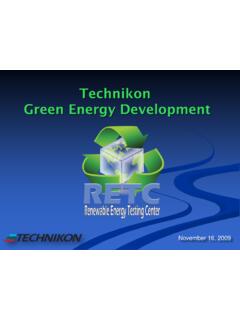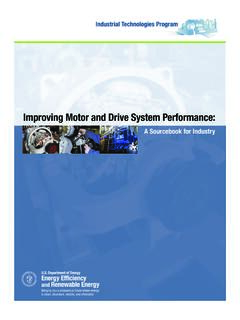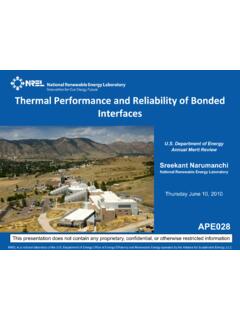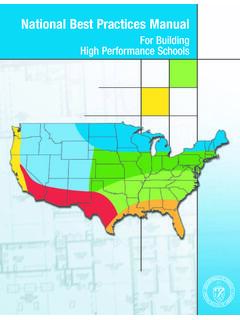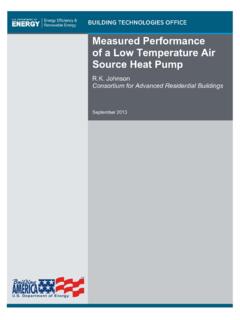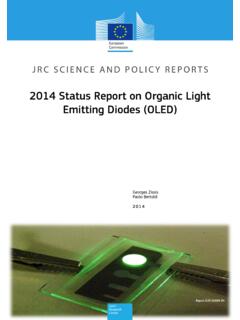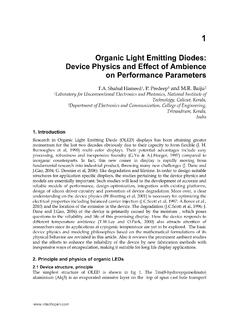Transcription of Organic Light Emitting Diodes (OLEDs) for General ...
1 Organic Light Emitting Diodes (OLEDs) for General Illumination Update 2002 AANN OOIIDDAA TTEECCHHNNOOLLOOGGYY RROOAADDMMAAPP Date August, 2002 Sponsored by: Optoelectronics Industry Development Association (OIDA) Department of Energy Office of Building Technology, State and Community Programs Edited by: Milan Stolka, Consultant Published by: 1133 Connecticut Avenue, NW #600 Washington, DC 20036 Ph: 202-785-4426 Fax: 202-785-4428 Web: OIDA Member Use Only 2002 OIDA Optoelectronics Industry Development Association All data contained in this report is proprietary to OIDA and may not be distributed in either original or reproduced form to anyone outside the client s internal organization within five years of the report date without prior written permission of OIDA.
2 Published by: Optoelectronics Industry Development Association 1133 Connecticut Ave., NW Suite 600 Washington, DC 20036-4380 Ph: (202) 785-4426; Fax: (202) 785-4428 Internet: OIDA OLEDs Update 2002 1 The US Department of Energy's Office of Building Technology (BT) is facilitating a public-private partnership to develop a series of technology roadmaps. The roadmaps identify key goals and strategies for improvements in buildings and equipment. The roadmap, or plan, is a fundamental component of the BT strategic plan and will help to align government resources with the high priority needs identified by industry and OIDA.
3 One such priority need at BT is the reduction of energy consumed for General illumination. Roadmaps such as this will guide cooperation among public and private researchers, lighting companies, private and state universities and State and federal offices. This roadmap effort, co-sponsored by the US Department of Energy's Office of Building Technology and OIDA and executed by OIDA (Optoelectronic Industry Development Association), has produced a research plan for Organic Light Emitting Diodes , in addressing the General illumination market.
4 The latest study at the US Department of Energy (1) shows that Quads (quadrillions of British Thermal Units - BTUs) were consumed in 2001 to provide lighting to commercial, residential and industrial buildings and stationary fixtures in the USA. This represents about 20% of all the electricity produced in the United States. This level of consumption, which is steadily increasing due to the raising affluence of our society, is not sustainable. It is now accepted that there is a need to develop viable methodologies to conserve 50% of the electric lighting load by the year 2010.
5 This cannot be achieved only by energy conservation, advanced electronic controls and more efficient lighting fixtures. The main enabler of the energy conservation effort will be new lighting technologies such as SSL (Solid State Lighting), specifically Light Emitting Diodes (LEDs) and Organic Light Emitting Diodes (OLEDs). SSL have the promise of replacing the existing Light sources, and at the same time * contribute to the reduction of energy consumption, * positively affect the greenhouse effect by reducing the emission of CO2, * create new industry and new jobs.
6 OLEDs will eventually displace area (distri-buted) sources such as fluorescent lamps, but in many applications also incandescent lamps. OLEDs will also create new lighting possibilities by enabling large area illumination sources, panels, ceilings, walls, partitions, fabrics etc. OLEDs have all the attributes to effectively compete with incandescent and fluorescent lighting, because they will * be much more energy efficient, * generate pleasing white Light with high CRI (Color Rendition Index), * enable "designer color" on demand, * provide new design opportunities for architects.
7 There are still many technical obstacles that have to be overcome before OLEDs become a viable alternative to fluorescent and incan-descent lighting. It has been the intent of OIDA and the DOE to develop a technology roadmap for OLEDs, which would identify the critical roadblocks and suggest pathways for overcoming those roadblocks. The OIDA road-mapping effort was first reviewed in the OIDA and the Department of Energy co-sponsored OLED workshop, which was held on Nov. 30 and Dec. 1, 2000 in Berkeley, CA, and then in another workshop held on April 5, 2002 at the 1.
8 Executive Summary OIDA OLEDs Update 2002 2 same location. Both workshops were attended by key technical experts on OLEDs. These workshops had several objectives: * To reach the industry consensus on the application of OLEDs in Solid State Lighting, * To enumerate the technologies that need to be developed and improved to support the goal that OLEDs become the source of Light for General illumination * To identify and examine major technical problems and roadblocks standing in the way for OLEDs to become a technology of choice for General lighting and provide the basis for developing a technology roadmap to achieve this goal.
9 * To identify long-term research issues. The conclusions of the workshops, the outline of the major research areas, and recommendations are included in Section 5. It is the opinion of the OLED experts and workshops participants that no fundamental obstacles now exist that would prevent OLEDs from achieving the above goal. In view of the recent progress in improving the device efficiency and useful life, all participants share the optimism that the goal will be achieved. However, many incremental advances and breakthroughs must be made in the technology.
10 These advances, which can overcome what can be called incremental roadblocks , will be made only if substantial research is carried out to enhance the understanding of the function of OLEDs and of the processes that cause their instability. Also, many novel high performance robust materials have to be synthesized, and the device architecture has to be optimized. The lack of commercially available specialty materials is an obstacle. Although the OLED experts had different outlooks, it was a General consensus that without a meaningful industry / government / academia collaboration and a substantial infusion of funds it would take 12 15 years before the commercialization of OLEDs for General lighting could be considered in the USA.

